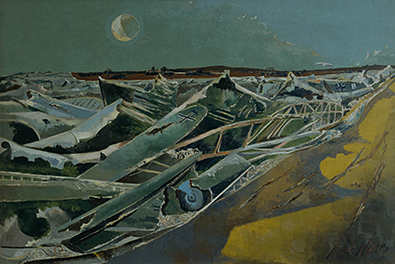British art of the first half of the twentieth century remains somewhat underrated and underappreciated. Over the last few years the Dulwich Picture Gallery has been quietly campaigning for a reappraisal of the work of key figures of the time, including Graham Sutherland and Walter Sickert. Now comes “Paul Nash: The Elements”. The show focusses on the landscapes created by the artist between about 1911, when he first set out on the path of a painter’s career, to 1946, when he died.
The exhibition tells the story of a sadly curtailed life, and of an art shaped by the trauma of the two World Wars. As a young man Nash read the verse of the Romantics, from Wordsworth to Rossetti, and wondered if he might himself become an idiosyncratic draughtsman-poet in the mould of William Blake. His earliest works include a series of small, dark pen-and-ink drawings in which Nash strove to develop his own equivalent to Blake’s symbolic language. An angel struggles with an eagle in a world of midnight obscurity. Pyramids persist by the light of the moon. Nash communed with the ghost of Samuel Palmer as well as that of Blake, but he soon developed his own, distinctive sense of English pastoral. He had a sense of the world as a place charged with wonder, where he could roam at will. He depicted the wide-open landscapes of Oxfordshire, where ancient burial mounds struck him as England’s very own version of the pyramids; he drew trees as if they were people, or perhaps guardian spirits watching over him.
Then came the First World War, and the ending of his innocence. His response was the blackened, brooding depiction of a landscape raped. With dark irony, he called it We Are Building a New World. The picture...


